果蔬采后病理
- 格式:ppt
- 大小:1.21 MB
- 文档页数:4
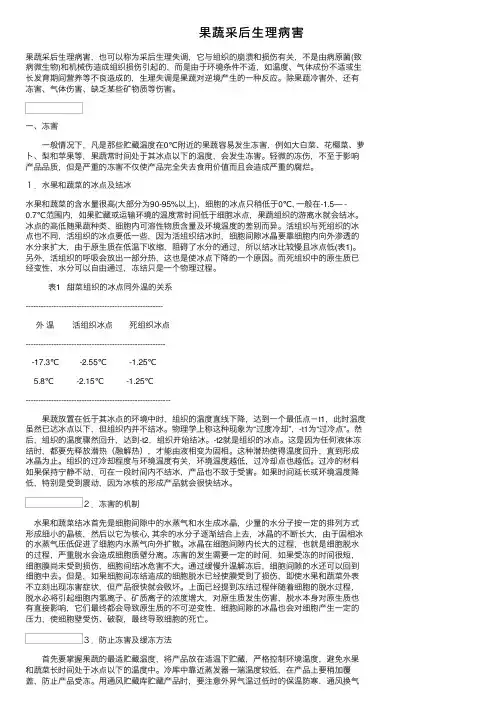
果蔬采后⽣理病害果蔬采后⽣理病害,也可以称为采后⽣理失调,它与组织的崩溃和损伤有关,不是由病原菌(致病微⽣物)和机械伤造成组织损伤引起的,⽽是由于环境条件不适,如温度、⽓体成份不适或⽣长发育期间营养等不良造成的,⽣理失调是果蔬对逆境产⽣的⼀种反应。
除果蔬冷害外,还有冻害、⽓体伤害、缺乏某些矿物质等伤害。
⼀、冻害 ⼀般情况下,凡是那些贮藏温度在0℃附近的果蔬容易发⽣冻害,例如⼤⽩菜、花椰菜、萝⼘、梨和苹果等,果蔬常时间处于其冰点以下的温度,会发⽣冻害。
轻微的冻伤,不⾄于影响产品品质,但是严重的冻害不仅使产品完全失去⾷⽤价值⽽且会造成严重的腐烂。
1.⽔果和蔬菜的冰点及结冰⽔果和蔬菜的含⽔量很⾼(⼤部分为90-95%以上),细胞的冰点只稍低于0℃, ⼀般在-1.5— -0.7℃范围内,如果贮藏或运输环境的温度常时间低于细胞冰点,果蔬组织的游离⽔就会结冰。
冰点的⾼低随果蔬种类、细胞内可溶性物质含量及环境温度的差别⽽异。
活组织与死组织的冰点也不同,活组织的冰点要低⼀些,因为活组织结冰时,细胞间隙冰晶要靠细胞内向外渗透的⽔分来扩⼤,由于原⽣质在低温下收缩,阻碍了⽔分的通过,所以结冰⽐较慢且冰点低(表1)。
另外,活组织的呼吸会放出⼀部分热,这也是使冰点下降的⼀个原因。
⽽死组织中的原⽣质已经变性,⽔分可以⾃由通过,冻结只是⼀个物理过程。
表1 甜菜组织的冰点同外温的关系------------------------------------------------------外温活组织冰点死组织冰点--------------------------------------------------------17.3℃ -2.55℃ -1.25℃5.8℃ -2.15℃ -1.25℃--------------------------------------------------------- 果蔬放置在低于其冰点的环境中时,组织的温度直线下降,达到⼀个最低点-t1,此时温度虽然已达冰点以下,但组织内并不结冰。
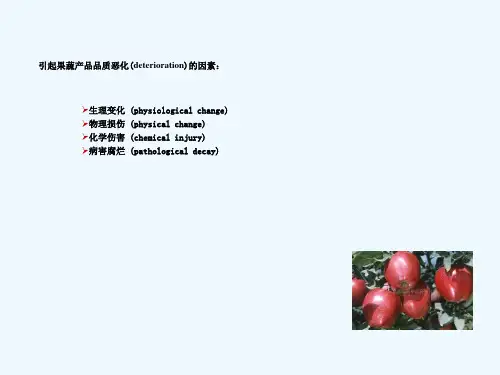
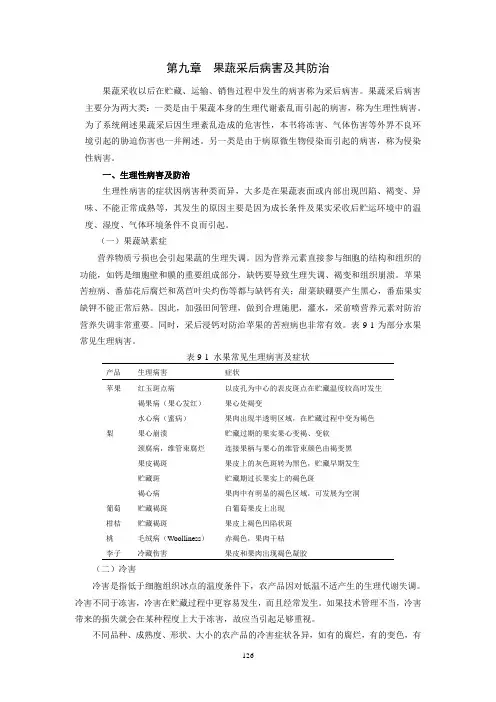
第九章果蔬采后病害及其防治果蔬采收以后在贮藏、运输、销售过程中发生的病害称为采后病害。
果蔬采后病害主要分为两大类:一类是由于果蔬本身的生理代谢紊乱而引起的病害,称为生理性病害。
为了系统阐述果蔬采后因生理紊乱造成的危害性,本书将冻害、气体伤害等外界不良环境引起的胁迫伤害也一并阐述。
另一类是由于病原微生物侵染而引起的病害,称为侵染性病害。
一、生理性病害及防治生理性病害的症状因病害种类而异,大多是在果蔬表面或内部出现凹陷、褐变、异味、不能正常成熟等,其发生的原因主要是因为成长条件及果实采收后贮运环境中的温度、湿度、气体环境条件不良而引起。
(一)果蔬缺素症营养物质亏损也会引起果蔬的生理失调。
因为营养元素直接参与细胞的结构和组织的功能,如钙是细胞壁和膜的重要组成部分,缺钙要导致生理失调、褐变和组织崩溃。
苹果苦痘病、番茄花后腐烂和莴苣叶尖灼伤等都与缺钙有关;甜菜缺硼要产生黑心,番茄果实缺钾不能正常后熟。
因此,加强田间管理,做到合理施肥,灌水,采前喷营养元素对防治营养失调非常重要。
同时,采后浸钙对防治苹果的苦痘病也非常有效。
表9-1为部分水果常见生理病害。
表9-1 水果常见生理病害及症状产品生理病害症状苹果梨葡萄柑桔桃李子红玉斑点病褐果病(果心发红)水心病(蜜病)果心崩溃颈腐病,维管束腐烂果皮褐斑贮藏斑褐心病贮藏褐斑贮藏褐斑毛绒病(Woolliness)冷藏伤害以皮孔为中心的表皮斑点在贮藏温度较高时发生果心处褐变果肉出现半透明区域,在贮藏过程中变为褐色贮藏过期的果实果心变褐、变软连接果柄与果心的维管束颜色由褐变黑果皮上的灰色斑转为黑色,贮藏早期发生贮藏期过长果实上的褐色斑果肉中有明显的褐色区域,可发展为空洞白葡萄果皮上出现果皮上褐色凹陷状斑赤褐色,果肉干枯果皮和果肉出现褐色凝胶(二)冷害冷害是指低于细胞组织冰点的温度条件下,农产品因对低温不适产生的生理代谢失调。
冷害不同于冻害,冷害在贮藏过程中更容易发生,而且经常发生。

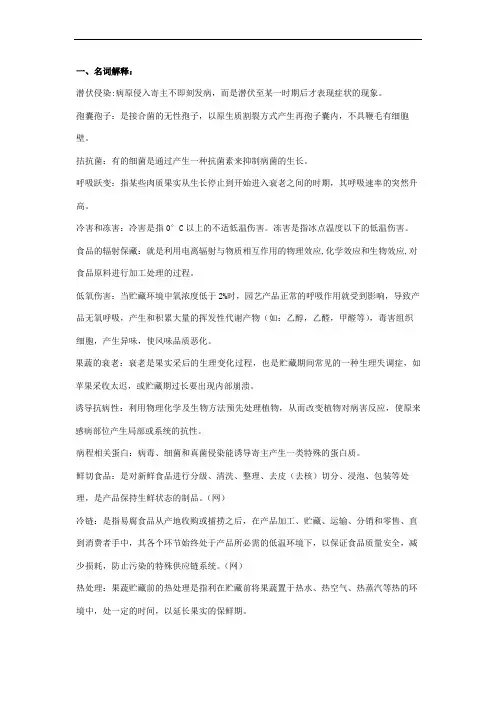
一、名词解释:潜伏侵染:病原侵入寄主不即刻发病,而是潜伏至某一时期后才表现症状的现象。
孢囊孢子:是接合菌的无性孢子,以原生质割裂方式产生再孢子囊内,不具鞭毛有细胞壁。
拮抗菌:有的细菌是通过产生一种抗菌素来抑制病菌的生长。
呼吸跃变:指某些肉质果实从生长停止到开始进入衰老之间的时期,其呼吸速率的突然升高。
冷害和冻害:冷害是指0°C以上的不适低温伤害。
冻害是指冰点温度以下的低温伤害。
食品的辐射保藏:就是利用电离辐射与物质相互作用的物理效应,化学效应和生物效应,对食品原料进行加工处理的过程。
低氧伤害:当贮藏环境中氧浓度低于2%时,园艺产品正常的呼吸作用就受到影响,导致产品无氧呼吸,产生和积累大量的挥发性代谢产物(如:乙醇,乙醛,甲醛等),毒害组织细胞,产生异味,使风味品质恶化。
果蔬的衰老:衰老是果实采后的生理变化过程,也是贮藏期间常见的一种生理失调症,如苹果采收太迟,或贮藏期过长要出现内部崩溃。
诱导抗病性:利用物理化学及生物方法预先处理植物,从而改变植物对病害反应,使原来感病部位产生局部或系统的抗性。
病程相关蛋白:病毒、细菌和真菌侵染能诱导寄主产生一类特殊的蛋白质。
鲜切食品:是对新鲜食品进行分级、清洗、整理、去皮(去核)切分、浸泡、包装等处理,是产品保持生鲜状态的制品。
(网)冷链:是指易腐食品从产地收购或捕捞之后,在产品加工、贮藏、运输、分销和零售、直到消费者手中,其各个环节始终处于产品所必需的低温环境下,以保证食品质量安全,减少损耗,防止污染的特殊供应链系统。
(网)热处理:果蔬贮藏前的热处理是指利在贮藏前将果蔬置于热水、热空气、热蒸汽等热的环境中,处一定的时间,以延长果实的保鲜期。
二、问答题低温冷藏保鲜的原理?低温可以明显地抑制病菌孢子萌发,侵染和致病力,同时还能抑制果实呼吸和生理代谢,延缓衰老,提高果实的抗性。
但是,采后贮藏温度的确定应以该产品不产生冷害的最低温度为宜。
降低果实的呼吸速率,课降低水果的呼吸代谢、病原菌的发病率和果实的腐烂率。


第五章园艺产品采后病害及其防治园艺产品采后在贮藏、流通期间发生的病害通称为采后病害(postharvest diseases)。
园艺产品的采后病害可分为两大类:生理失调(physiological disorder)病理病害(pathological decay)第一节果蔬贮藏中发生的生理失调(逆境伤害)果蔬采后的生理失调也称为采后生理病害,是由于环境条件不适或生长发育期间营养不良造成。
一切会引起生物体生理功能失常的环境条件都属于逆境(Stress)。
生理失调是果蔬对逆境产生的一种反应。
逆境伤害主要有低温伤害(冷害及冻害)、气体伤害Question 1降温贮藏是延长果蔬贮藏期的一种主要方法。
低温对果蔬有何有利影响?有什么不利影响?一、冷害(Chilling injury)概念:果蔬在其组织冰点以上的低温中贮藏时发生的代谢失调称为冷害。
Question 2是否各种果蔬在低温贮藏时都有可能发生冷害?•冷害发生的可能性与果蔬的品种、种类有关;•易发生冷害的产品称为冷敏感产品。
冷敏作物低温贮藏不当时,害处多于益处,不仅藏的优越性不能充分体现,产品还会迅速败坏,贮藏寿命缩短。
•冷害发生的温度依果蔬的不同而有较大差异,一般在0~15℃。
大部分果蔬短暂受冷后回到暖处仍可以恢复正常代谢,长久受冷后则组织和细胞受到损伤,不能恢复正常代谢。
二、冷害的症状及生理变化1、冷害常见的症状①表皮凹陷②退绿、果皮变黑③水渍状④烫伤状⑤腐烂,坏死⑥后熟果实如香蕉、芒果将不能成熟或成熟不正常⑦产生异味(如油梨、柑桔等)⑧果肉褪色(番茄)冷害后显微结构的变化: 线粒体肿胀解体内质网肿胀核糖体消失细胞核染色质聚集液泡破裂2、冷害发生后的生理生化变化◎呼吸速率及呼吸商改变冷害开始时,呼吸速率异常增加;随着冷害发展,呼吸速率下降;◎果蔬细胞膜受到伤害,透性增加,离子相对渗出率上升;◎由于细胞膜受伤害,使乙烯合成酶系统活性明显降低;◎三羧酸循环发生混乱,导致中间产物α-酮酸积累。
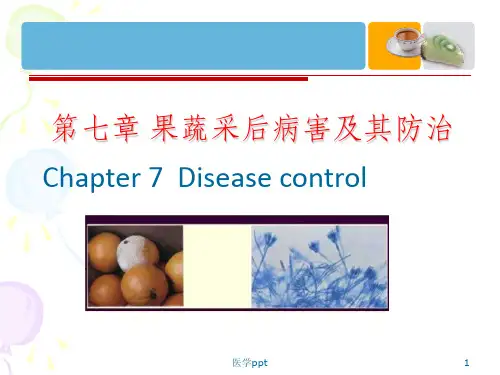
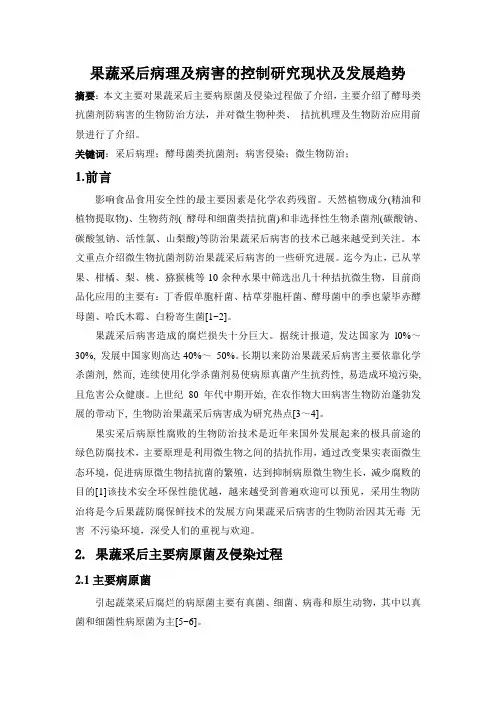
果蔬采后病理及病害的控制研究现状及发展趋势摘要:本文主要对果蔬采后主要病原菌及侵染过程做了介绍,主要介绍了酵母类抗菌剂防病害的生物防治方法,并对微生物种类、拮抗机理及生物防治应用前景进行了介绍。
关键词:采后病理;酵母菌类抗菌剂;病害侵染;微生物防治;1.前言影响食品食用安全性的最主要因素是化学农药残留。
天然植物成分(精油和植物提取物)、生物药剂( 酵母和细菌类拮抗菌)和非选择性生物杀菌剂(碳酸钠、碳酸氢钠、活性氯、山梨酸)等防治果蔬采后病害的技术已越来越受到关注。
本文重点介绍微生物抗菌剂防治果蔬采后病害的一些研究进展。
迄今为止,已从苹果、柑橘、梨、桃、猕猴桃等10余种水果中筛选出几十种拮抗微生物,目前商品化应用的主要有:丁香假单胞杆菌、枯草芽胞杆菌、酵母菌中的季也蒙毕赤酵母菌、哈氏木霉、白粉寄生菌[1~2]。
果蔬采后病害造成的腐烂损失十分巨大。
据统计报道, 发达国家为l0%~30%, 发展中国家则高达40%~50%。
长期以来防治果蔬采后病害主要依靠化学杀菌剂, 然而, 连续使用化学杀菌剂易使病原真菌产生抗药性, 易造成环境污染, 且危害公众健康。
上世纪80 年代中期开始, 在农作物大田病害生物防治蓬勃发展的带动下, 生物防治果蔬采后病害成为研究热点[3~4]。
果实采后病原性腐败的生物防治技术是近年来国外发展起来的极具前途的绿色防腐技术,主要原理是利用微生物之间的拮抗作用,通过改变果实表面微生态环境,促进病原微生物拮抗菌的繁殖,达到抑制病原微生物生长,减少腐败的目的[1]该技术安全环保性能优越,越来越受到普遍欢迎可以预见,采用生物防治将是今后果蔬防腐保鲜技术的发展方向果蔬采后病害的生物防治因其无毒无害不污染环境,深受人们的重视与欢迎。
2. 果蔬采后主要病原菌及侵染过程2.1主要病原菌引起蔬菜采后腐烂的病原菌主要有真菌、细菌、病毒和原生动物,其中以真菌和细菌性病原菌为主[5~6]。
2.1.1 真菌真菌是最主要和最流行的病原微生物,侵染广,危害大,是造成果菜类在贮藏运输期间损失的重要原因。

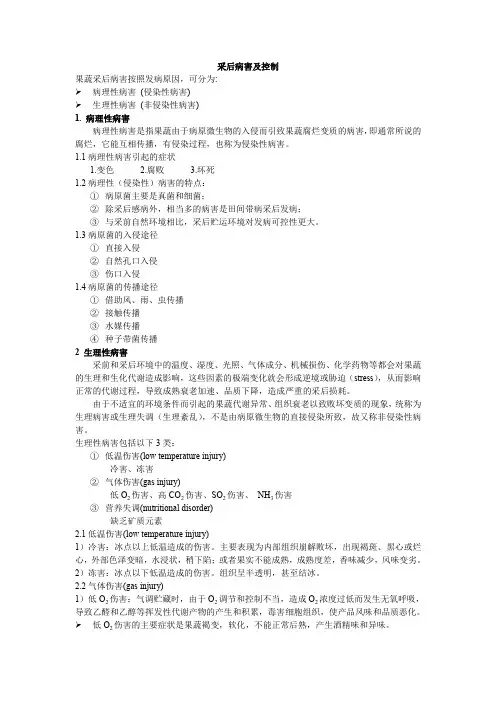
采后病害及控制果蔬采后病害按照发病原因,可分为:病理性病害(侵染性病害)生理性病害(非侵染性病害)1. 病理性病害病理性病害是指果蔬由于病原微生物的入侵而引致果蔬腐烂变质的病害,即通常所说的腐烂,它能互相传播,有侵染过程,也称为侵染性病害。
1.1病理性病害引起的症状1.变色2.腐败3.坏死1.2病理性(侵染性)病害的特点:①病原菌主要是真菌和细菌;②除采后感病外,相当多的病害是田间带病采后发病;③与采前自然环境相比,采后贮运环境对发病可控性更大。
1.3病原菌的入侵途径①直接入侵②自然孔口入侵③伤口入侵1.4病原菌的传播途径①借助风、雨、虫传播②接触传播③水媒传播④种子带菌传播2 生理性病害采前和采后环境中的温度、湿度、光照、气体成分、机械损伤、化学药物等都会对果蔬的生理和生化代谢造成影响,这些因素的极端变化就会形成逆境或胁迫(stress),从而影响正常的代谢过程,导致成熟衰老加速、品质下降,造成严重的采后损耗。
由于不适宜的环境条件而引起的果蔬代谢异常、组织衰老以致败坏变质的现象,统称为生理病害或生理失调(生理紊乱),不是由病原微生物的直接侵染所致,故又称非侵染性病害。
生理性病害包括以下3类:①低温伤害(low temperature injury)冷害、冻害②气体伤害(gas injury)低O2伤害、高CO2伤害、SO2伤害、NH3伤害③营养失调(nutritional disorder)缺乏矿质元素2.1低温伤害(low temperature injury)1)冷害:冰点以上低温造成的伤害。
主要表现为内部组织崩解败坏,出现褐斑、黑心或烂心,外部色泽变暗,水浸状,稍下陷;或者果实不能成熟,成熟度差,香味减少,风味变劣。
2)冻害:冰点以下低温造成的伤害。
组织呈半透明,甚至结冰。
2.2气体伤害(gas injury)1)低O2伤害:气调贮藏时,由于O2调节和控制不当,造成O2浓度过低而发生无氧呼吸,导致乙醛和乙醇等挥发性代谢产物的产生和积累,毒害细胞组织,使产品风味和品质恶化。
•Contents:1. Basic characteristic of fresh plant products.2. Losses and quality deterioration in fresh plant products after harvest.3. Factors influence fresh plant products quality.Chapter 0 Introduction•Contents:4. Contents of post-harvest biology and post-harvest physiology.5. Importance of post-harvest Biology in maintaining quality and decreasing loss of post-harvest fresh plant products.Chapter 1 Respiratory Metabolism•Objects:•To know concept and significance of respiration•To familiar with the process of respiratory metabolism•To know factors affecting respiration and the methods of respiration controlChapter 1 Respiratory Metabolism•Contents:•1. Introduction•2. Factors Affecting Respiration• 2.1 Temperature• 2.2 Atmospheric Composition• 2.3 Physical Stress• 2.4 Stage of Development•2.5 Other Factors (Type of plant products, Humidity, Disease or Insect Attack, Plant Growth Regulators, etc.)Chapter 1 Respiratory MetabolismSignificance of Respiration ;Shelf-life and Respiration Rate;Loss of Substrate;Synthesis of New Compounds;Release of Heat Energy ;Meaning of the Respiratoy Quotient (RQ);Measuring the Rate of Respiration ; Biochemistry of Respiration1 IntroductionAll of the commodities covered in this handbook are alive and carry on processes characteristics of all living things. One of the most important of these is respiratory metabolism.The process of respiration involves combing oxygen in the air with organic molecules in the tissue (usually a sugar) to form various intermediate compounds and eventually CO2 and water.The energy produced by the series of reactions comprising respiration can be captured as high energy bonds in compounds used by the cell in subsequent reactions, or lost as heat.The energy and organic molecules produced during respiration are used by other metabolic processes to maintain the health of the commodity.Heat produced during respiration is called vital heat and contributes to the refrigeration load that must be considered in designing storage rooms.In general, the storage life of commodities varies inversely with the rate of respiration.This is because respiration supplies compounds that determine the rate of metabolic processes directly related to quality parameters, e.g., firmness, sugar content, aroma, flavor, etc.Commodities and cultivars with higher rates of respiration tend to have shorter storage-life than those with low rates of respiration.Storage life of broccoli, lettuce, peas, spinach, and sweet corn (all of which have high respiration rates) is short in comparison to that of apples, cranberries, limes, onions, and potatoes - all of which have low respiration rates (Table 1).Table 1. Respiration rates of a range of perishable commoditiesClass Range at (mg CO2 kg-1 h-1)CommoditiesV ery Low < 5 Nuts, datesLow 5 to 10 Apple, citrus, grape,kiwifruit, onion, potatoModerate 10 to 20 Apricot, banana, cherry, peach,nectarine, pear, plum, fig, carrot,cabbage, lettuce, pepper, tomatoHigh 20 to 40 Strawberry, blackberry, bean, lima,avocado, raspberry, cauliflowerV ery High 40 to 60 Artichoke, snap bean,Brussels sprouts, cut flowersExtremely High > 60 Asparagus, broccoli, mushroom,pea, spinach, sweet corn 2 Factors Affecting RespirationRespiration is affected by a wide range of environmental factors that include:light,;chemical stress (e.g., fumigants);radiation stress, water stress, growth regulators, pathogen attack.The most important post-harvest factors are temperature,atmospheric composition,and physical stress.2.1 TemperatureWithout a doubt, the most important factor affecting post-harvest life is temperature.This is because temperature has a profound affect on the rates of biological reactions, e.g., metabolism and respiration.Over the physiological range of most crops, i.e., 0 to 30 °C, increased temperatures cause anexponential rise in respiration.The V an't Hoff Rule states that the velocity of a biological reaction increases 2 to 3-fold for every 10 °C rise in temperature.The temperature quotient for a 10 °C interval is called the Q10.The Q10 can be calculated by dividing the reaction rate at a higher temperature by the rate at a 10 °C lower temperature, i.e., Q10 = R2/R1.The temperature quotient is useful because it allows us to calculate the respiration rates at one temperature from a known rate at another temperature.However, the respiration rate does not follow ideal behavior, and the Q10can vary considerably with temperature.At higher temperatures, the Q10 is usually smaller than at lower temperatures.Typical figures for Q10 are:T emperature Q100 to 10 °C 2.5 to 4.010 to 20 °C 2.0 to 2.520 to 30 °C 1.5 to 2.030 to 40 °C 1.0 to 1.5These typical Q10values allow us to construct a table showing the effect of different temperatures on the rates of respiration or deterioration and relative shelf life of a typical perishable commodity (Table 2).Table 2. Effect of temperature on rate of deteriorationT emperature Assumed Relative velocity Relative(°C) Q10of deterioration shelf-life0 - 1.0 10010 3.0 3.0 3320 2.5 7.5 1330 2.0 15.0 740 1.5 22.5 4This table shows that if a commodity has a mean shelf-life of 13 days at 20 °C it can be stored for as long as 100 days at 0 °C, but will last no more than 4 days at 40 °C.Chilling stressAlthough respiration is normally reduced at low, but non-freezing temperatures, certain commodities, chiefly those originating in the tropics and subtropics, exhibit abnormal respiration when their temperature falls below 10 to 12 °C.Typically the Q10 is much higher at these low temperatures for chilling sensitive crops than it would be for chilling tolerant ones.Chilling stressRespiration may increase dramatically at the chilling temperatures or when the commodity is returned to non-chilling temperatures.This enhanced respiration presumably reflects the cells' efforts to detoxify metabolic intermediates that accumulated during chilling, as well as to repair damage to membranes and other sub-cellular structures.Chilling stressEnhanced respiration is only one of many symptoms that signal the onset of chilling injury.An economically important low temperature phenomenon discussed in more detail in a subsequent chapter.Heat stressAs the temperature rises beyond the physiological range, the rate of increase in respiration falls.It becomes negative as the tissue nears its thermal death point, when metabolism is disorderly and enzyme proteins are denatured (变性).Heat stressMany tissues can tolerate high temperatures for short periods of time (e.g., minutes), and this property is used to advantage in killing surface fungi on some fruits.Continued exposure to high temperatures causes phyto-toxic symptoms, and then complete tissue collapse.Heat stressHowever, conditioning and heat shocks, i.e., short exposure to potentially injurious temperatures, can modify the tissue‟s responses to subsequent harmful stresses.2.2 Atmospheric CompositionAdequate O2 levels are required to maintain aerobic respiration (有氧呼吸).The exact level of O2that reduces respiration while still permitting aerobic respiration varies with commodity.In most crops, O2level around 2 to 3% produces a beneficial reduction in the rate of respiration and other metabolic reactions.Levels as low as 1% improve the storage life of some crops, e.g., apples, but only when the storage temperature is optimal.At higher storage temperatures, the demand for A TP may outstrip(超过) the supply and promote anaerobic respiration (无氧呼吸).The need for adequate O2 should be considered in selecting the various post-harvest handling procedures, such as waxing and other surface coatings, film wrapping, and packaging.Unintentional modification of the atmosphere, e.g., packaging, can result in production of undesirable fermentative products and development of foul odors (异味).Increasing the CO2level around some commodities reduces respiration, delays senescence and retards fungal growth.In low O2 environments, however, increased CO2 levels can promote fermentative metabolism.Some commodities tolerate brief (e.g., a few days at low temperatures) storage in a pure N2 atmosphere, or in very high concentrations of CO2.High CO2 treatmentThe biochemical basis of their ability to withstand these atmospheres is unknown.2.3Physical StressWound respiration (伤呼吸)mechanical injuryinsect attackpathogen infectionchilling injurygas injuryWound-induced ethylene (伤害乙烯)Even mild (轻微的) physical stress can perturb (扰乱) respiration, while physical abuse can cause a substantial rise in respiration that is often associated with increased ethylene evolution.The signal produced by physical stress migrates from the site of injury and induces a wide range of physiological changes in adjacent (临近的), non-wounded tissue.Some of the more important changes include enhanced respiration, ethylene production, phenolic metabolism and wound healing.Wound-induced respiration is often transitory(短暂的), lasting a few hours or days.However, in some tissues wounding stimulates developmental changes, e.g., promote ripening, that result in a prolonged increase in respiration.Ethylene stimulates respiration and stress-induced ethylene may have many physiological effects on commodities besides stimulating respiration.2.4 Stage of DevelopmentRespiration rates vary among and within commodities.Storage organs such as nuts and tubers (坚果和块茎)have low respiration rates.Tissues with vegetative or floral meristems (分生组织) such as asparagus and broccoli have very high respiration rates.As plant organs mature, their rate of respiration typically declines.This means that commodities harvested during active growth, such as many vegetables and immature fruits, have high respiration rates.Mature fruits, dormant buds (休眠芽) and storage organs have relatively low rates.After harvest, the respiration rate typically declines; slowly in non-climacteric fruits(非跃变型果实)and storage organs, rapidly in vegetative tissues (营养组织)and immature fruits.The rapid decline presumably reflects depletion(消耗) of respirable substrates (呼吸底物) that are typically low in such tissues.An important exception to the general decline in respiration following harvest is the rapid and sometimes dramatic rise in respiration during the ripening of climacteric fruit (Fig. 1). climacteric fruit(跃变型果实)non-climacteric fruits(非跃变型果实)Figure1.The climacteric pattern of respiration in ripening fruit2.4 Stage of Developmentclimacteric fruit (跃变型果实)This rise, which has been the subject of intense study for many years, normally consists of four distinct phases:1) pre-climacteric minimum,2) climacteric rise,3) climacteric peak, and4) post-climacteric decline.The division of fruits into climacteric and non-climacteric types has been very useful for post-harvest physiologists.However, some fruits, for example kiwifruit and cucumber, appear to blur the distinction between the groups.Respiratory rises also occur during stress and other developmental stages, but a true climacteric only occurs coincident with fruit ripening.Following is a general classification of fruits according to their respiratory behavior during ripening:Climacteric Fruits Non-Climacteric FruitsApple Papaya Blueberry CitrusApricot Passion fruit Cacao LycheeA vocado Peach Caju LonganBanana Pear Cherry LoquatBiriba Persimmon CucumberBreadfruit PlumGrape Cherimoya Sapote GrapefruitFeijoa Soursop LemonFig Tomato LimeGuava Watermelon OliveJackfruit OrangeKiwifruit PepperMango PineappleMuskmelon StrawberryNectarine TamarilloDifferences between climacteric fruits and non-climacteric fruits1、概念:C a r b o n d i o x i d e p r o d u c t i o n2、呼吸强度大小:3、乙烯产生量大小:4、乙烯合成系统:5、对外源乙烯的反应:(施用时期、乙烯浓度)6、呼吸高峰:7、耐贮性:8、后熟性:Different kinds of agricultural product can not store at the same storage room, especially climacteric fruits and non-climacteric fruits(1)不同的农产品其贮藏的条件。
绪论一果蔬采后生理学是研究果树和蔬菜可食用的根、茎、叶、花、果实及其变态器官采收后的生命活动规律,以及其调控原理的一门科学。
采后的新鲜果蔬产品在贮藏、运输及销售系统中仍然是有生命活动的有机体,同采前一样仍然进行新陈代谢活动,所以,果蔬组织中所发生的生理生化变化在很大程度上是这些有机体在生长时期所发生的代谢过程的继续。
但是,采后的果蔬在贮运期间所发生的代谢过程与生长发育期间又有许多不同的方面,采后果蔬不再从土壤中吸取水分和养分,基本上不再进行光合作用。
因此,果蔬采后的生命活动是在呼吸作用等基本代谢的基础上,表现出的成熟与衰老的生理生化过程。
“十五”以来,我国果蔬产业得到迅猛发展,蔬菜的面积和产量分别占到世界总量的41.7%和47.7%;果树面积占世界的20.2%,产量占14.5%。
随着农业产业结构调整和市场需求的增加,新农村建设战略实施,国家出台了一系列促进农业发展的优惠政策,我国果蔬产业异军突起。
其中,我国水果年产量已达1.5亿吨(含果用瓜),蔬菜产量5.5亿吨。
随着生产、市场、运输技术的改进,中国果蔬的贸易额尤其是出口额在国际市场上的份额一直在上升,2006年我国蔬果及其制品出口创汇近100亿美元。
果蔬产业已经成为我国农业农村经济的支柱产业和农民收入的重要来源,并已进入新的发展阶段,集经济、生态、文化功能于一身。
我国果蔬产业发展空间广阔,商机无限。
从世界范围来说,长期以来人类一直面临食品短缺的问题,但是作为人类生活所必需的果蔬食品,因其以鲜嫩品质为特征,含水量高,不易保存,采后腐烂变质损失一般高达25%,有些易腐果蔬产品采后损失超过30%以上,我国果蔬采后损失也极为普遍而且严重,1985年我国瓜果总产量为1651.8万吨(不包括蔬菜),损失达到370万吨,价值人民币18.5亿元。
据保守的估计,园艺作物的采后损失几乎可以满足两亿人的基本营养要求(ArLhur Kelmen,1984)。
由此可见,果蔬采后损失是一个全球性的问题(NAS,1978)。